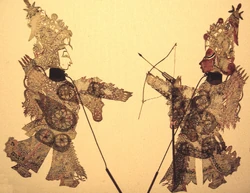- This page is about the theater technique. For The Twilight Zone episode, see Shadow Play.
| This article is written from the Real world point of view |

Chinese shadow puppets
Shadow play or shadow puppetry is a form of storytelling that dates back to ancient times. It is accomplished using opaque figures placed in front of an illuminated background to create the illusion of moving imagery.[1]
Shadow plays are said to have originated during the Han Dynasty (202 BC–220 AD) when it was used to lessen the grief that Emperor Wu of Han felt when one of his concubines died.[1] The story suggests that he assigned an occultist in his court the task of bringing her back to life.[2] In this effort, he fashioned a puppet in the shape of the concubine and made it move using articulated joints and an oil lamp to provide an animated shadow.[3][4]
The art became popular amongst the Mongols in the 13th century, taking it with them to distant lands like Persia, Arabia and Turkey.[1] The Ottoman Empire would develop their own Turkish variation of the technique in the 14th century, with all the actions and voices performed by a single puppet master backed by traditional Ottoman music.[5]
Shadow puppetry was later taken to France from missionaries in China during the 18th century. Its popularity in the nation peaked during the 19th century, when it was commonly performed in the nightclubs of Paris.[2] The dramatic technique had a major influence on other theatrical productions, including phantasmagoria, another type of theater that used shadows, smoke, screens, and projections to create ghostly effects.[6]
Notes and References[]
Notes[]
- ↑ 1.0 1.1 1.2 Wikipedia contributors. "Shadow play." Wikipedia, the Free Encyclopedia. Version: 2009-05-11. Retrieved: 2009-05-15.
- ↑ 2.0 2.1 Chinavista. "Chinavista." The Shadow Show. Retrieved: 2009-05-16.
- ↑ Franzeska G. Ewart. Let the Shadows speak: developing children's language through shadow puppetry. (1998). ISBN 1858560993
- ↑ Berthold Laufer. Oriental Theatricals. Field Museum of Natural history Chicago. (1923).
- ↑ Burak Sansal. "Karagöz and Hacivat, a Turkish shadow play." All About Turkey. Retrieved: 2009-05-16.
- ↑ The Spirit of Montmartre: Cabarets, Humour and the Avant-Garde, 1875-1905. edited by Phillip Dennis Cate and Mary Shaw (1996) , excerpted online as Henri Riviere: Le Chat noir and 'Shadow Theatre'.
